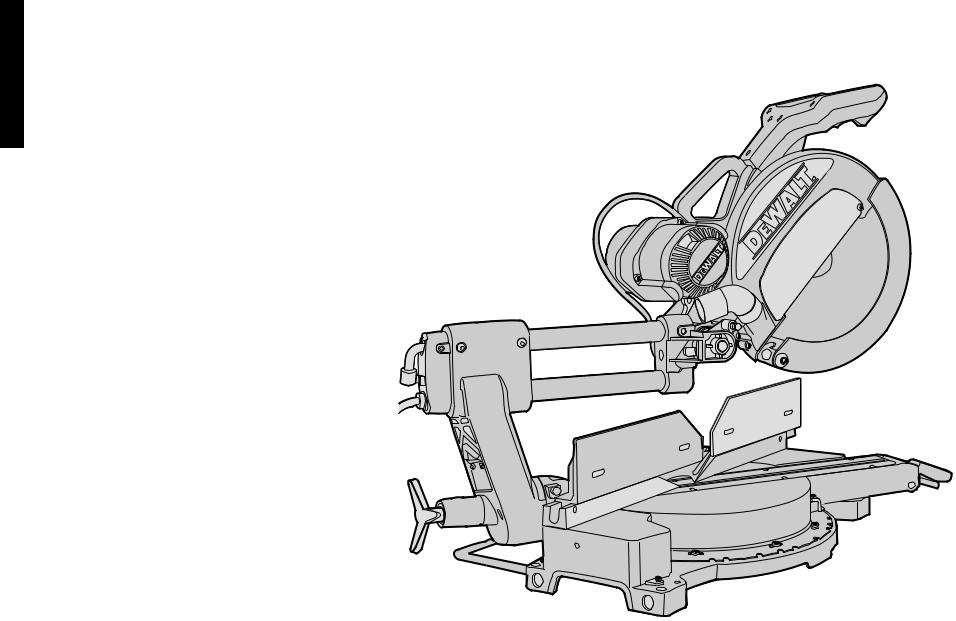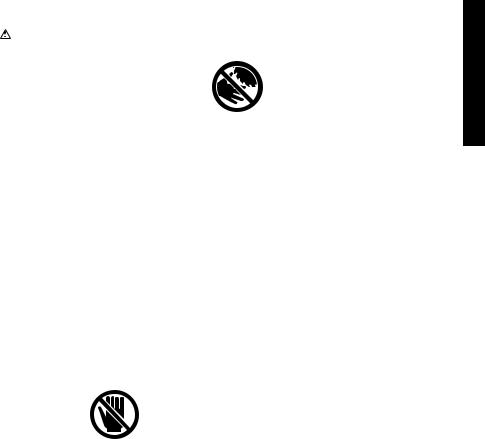DeWalt DW708 User Manual
DEWALT Industrial Tool Co., 701 East Joppa Road, Baltimore, MD 21286 |
Printed in U.S.A. (MAR01-CD-1) |
Form No. 386762-02 |
DW708 |
Copyright © 2001 |
|

|
|
IF YOU SHOULD EXPERIENCE A PROBLEM WITH YOUR DEWALT PURCHASE, |
|
|
|
|
Before returning this product call |
CALL 1-800-4 DEWALT. |
|
|
IN MOST CASES, A DEWALT REPRESENTIVE CAN RESOLVE YOUR |
|
1-800-4-DEWALT |
PROBLEM OVER THE PHONE. |
|
IF YOU HAVE A SUGGESTION OR COMMENT, GIVE US A CALL. |
|
|
YOUR FEEDBACK IS VITAL TO THE SUCCESS OF DEWALT'S |
|
|
|
QUALITY IMPROVEMENT PROGRAM. |
|
|
|
See our catalog on the World Wide Web at www.dewalt.com
INSTRUCTION MANUAL GUIDE D'UTILISATION MANUAL DE INSTRUCCIONES
INSTRUCTIVO DE OPERACIÓN, CENTROS DE SERVICIO Y PÓLIZA DE GARANTÍA.ADVERTENCIA: LÉASE ESTE INSTRUCTIVO ANTES DE USAR EL PRODUCTO.
DW708 Sliding Compound Miter Saw DW708 Scie à onglets mixtes coulissants
DW708 Sierra de ángulo compuesto (ingleteadora) corrediza

IF YOU HAVE ANY QUESTIONS OR COMMENTS ABOUT THIS OR ANY DEWALT TOOL, CALL US TOLL FREE AT:
1-800-4-DEWALT (1-800-433-9258)
English
This product is covered under U.S. Patent No. 5,199,343 and other patents pending.
DEWALT… BUILT JOBSITE TOUGH
DEWALT high performance industrial tools are made for America’s toughest industrial and construction applications. The design of every tool in the line
– from drills, to sanders, to grinders – is the result of rigorous use on jobsites and throughout the industry. Each tool is produced with painstaking precision using advanced manufacturing systems and intense quality control. Every tool is checked before it leaves the factory to make sure that it meets your standards for durability, reliability and power.
DEWALT Built Jobsite Tough…WE GUARANTEE IT.

TABLE OF CONTENTS |
|
SAFETY INSTRUCTIONS ................................................................................................... |
2 |
ADDITIONAL SAFETY RULES............................................................................................ |
2 |
DOUBLE INSULATION/POLARIZED PLUG................................................................. |
2 |
EXTENSION CORDS ................................................................................................... |
2 |
ELECTRICAL CONNECTION.............................................................................................. |
4 |
UNPACKING YOUR SAW ............................................................................................ |
4 |
FAMILIARIZATION ....................................................................................................... |
4 |
CONTROLS .................................................................................................................. |
4 |
SPECIFICATIONS ........................................................................................................ |
5 |
OPTIONAL ATTACHMENTS/ACCESSORIES ............................................................. |
5 |
BENCH MOUNTING ..................................................................................................... |
6 |
TRANSPORTING THE SAW ........................................................................................ |
6 |
ADJUSTMENTS............................................................................................................ |
7 |
MITER SCALE ADJUSTMENT ..................................................................................... |
7 |
MITER POINTER ADJUSTMENT................................................................................. |
7 |
MITER LOCK/DETENT ROD ADJUSTMENT............................................................... |
7 |
BEVEL STOP ............................................................................................................... |
7 |
FENCE ADJUSTMENT................................................................................................. |
8 |
GUARD ACTUATION AND VISIBILITY ........................................................................ |
8 |
AUTOMATIC ELECTRIC BRAKE ................................................................................. |
8 |
RAIL GUIDE ADJUSTMENT......................................................................................... |
9 |
BRUSHES..................................................................................................................... |
9 |
OPERATION ................................................................................................................. |
9 |
SWITCH ........................................................................................................................ |
9 |
CUTTING WITH YOUR SAW ....................................................................................... |
9 |
CROSSCUTS................................................................................................................ |
9 |
BEVEL CUTS................................................................................................................ |
9 |
QUALITY OF CUT ........................................................................................................ |
9 |
BODY AND HAND POSITION ...................................................................................... |
9 |
CLAMPING THE WORKPIECE .................................................................................. |
10 |
SUPPORT FOR LONG PIECES................................................................................. |
10 |
CUTTING PICTURE FRAMES, SHADOW BOXES AND |
|
OTHER FOUR SIDED PROJECTS ............................................................................ |
10 |
CUTTING TRIM MOULDING AND OTHER FRAMES ................................................ |
10 |
CUTTING COMPOUND MITERS ............................................................................... |
11 |
DUAL RANGE MITER SCALE.................................................................................... |
11 |
VERNIER SCALE ...................................................................................................... |
11 |
CUTTING BASE MOLDING........................................................................................ |
12 |
CUTTING CROWN MOLDING ................................................................................... |
13 |
SPECIAL CUTS .......................................................................................................... |
15 |
INSTALLING A NEW SAW BLADE ............................................................................ |
15 |
REMOVING AND REPLACING BELT ........................................................................ |
16 |
MAINTENANCE .......................................................................................................... |
16 |
WARRANTY................................................................................................................ |
16 |
TROUBLE SHOOTING GUIDE................................................................................... |
17 |
English
1

English
Important Safety Instructions for all tools.
 WARNING: For your own safety read instruction manual before operating sliding compound miter saw.
WARNING: For your own safety read instruction manual before operating sliding compound miter saw.
 WARNING: When using electric tools, basic safety precautions should always be followed to reduce risk of fire, electric shock, and personal injury, including the following:
WARNING: When using electric tools, basic safety precautions should always be followed to reduce risk of fire, electric shock, and personal injury, including the following:
Double Insulation
Double insulated tools are constructed throughout with two separate layers of electrical insulation or one double thickness of insulation between you and the tool’s electrical system. Tools built with this insulation system are not intended to be grounded. As a result, your tool is equipped with a two prong plug which permits you to use extension cords without concern for maintaining a ground connection.
NOTE: Double insulation does not take the place of normal safety precautions when operating this tool. The insulation system is for added protection against injury resulting from a possible electrical insulation failure within the tool.
 CAUTION: WHEN SERVICING USE ONLY IDENTICAL REPLACEMENT PARTS. Repair or replace damaged cords.
CAUTION: WHEN SERVICING USE ONLY IDENTICAL REPLACEMENT PARTS. Repair or replace damaged cords.
Polarized Plugs
To reduce the risk of electric shock, this equipment has a polarized plug (one blade is wider than the other). This plug will fit in a polarized outlet only one way. If the plug does not fit fully into the outlet, reverse the plug. If it still does not fit, contact a qualified electrician to install the proper outlet. Do not change the plug in any way.
Important Safety Instructions
•KEEP GUARDS IN PLACE and in working order.
•REMOVE ADJUSTING KEYS AND WRENCHES. Form habit of checking to see that keys and adjusting wrenches are removed from tool before turning it on.
•KEEP WORK AREA CLEAN. Cluttered areas and benches invite injuries.
•DON’T USE IN DANGEROUS ENVIRONMENT. Don’t use power tools in damp or wet locations, or expose them to rain or snow. Keep work area well lighted.
•KEEP CHILDREN AWAY. All visitors should be kept safe distance from work area.
•MAKE WORKSHOP KID PROOF with padlocks, master switches, or by removing starter keys.
•DON’T FORCE TOOL. It will do the job better and safer at the rate for which it was designed.
•USE RIGHT TOOL. Don’t force tool or attachment to do a job for which it was not designed.
•USE PROPER EXTENSION CORD. Make sure your extension cord is in good condition. When using an extension cord, be sure to use one heavy enough to carry the current your product will draw. An undersized cord will cause a drop in line voltage resulting in loss of power and overheating. The following table shows the correct size to use depending on cord length and nameplate ampere rating. If in doubt, use the next heavier gage. The smaller the gage number, the heavier the cord.
|
|
|
Minimum Gage for Cord Sets |
|
||
Volts |
|
|
Total Length of Cord in Feet |
|||
120V |
|
|
0-25 |
26-50 |
51-100 |
101-150 |
240V |
|
|
0-50 |
51-100 |
101-200 |
201-300 |
Ampere Rating |
|
AWG |
|
|||
More |
|
Not more |
|
|
||
Than |
|
Than |
|
|
|
|
0 |
- |
6 |
18 |
16 |
16 |
14 |
6 |
- |
10 |
18 |
16 |
14 |
12 |
10 |
- |
12 |
16 |
16 |
14 |
12 |
12 |
- |
16 |
14 |
12 |
Not Recommended |
|
•WEAR PROPER APPAREL. Do not wear loose clothing, gloves, neckties, rings, bracelets, or other jewelry which may get caught in moving parts. Nonslip footwear is recommended. Wear protective hair covering to contain long hair.
•ALWAYS USE SAFETY GLASSES. Also use face or dust mask if cutting operation is dusty. Everyday eyeglasses only have impact resistant lenses, they are not safety glasses.
•SECURE WORK. Use clamps or vise when you cannot secure the workpiece on the table and against the fence by hand or when your hand will be dangerously close to the blade (within 6”)
•DON’T OVERREACH. Keep proper footing and balance at all times.
•MAINTAIN TOOLS WITH CARE. Keep tools sharp and clean for best and safest performance. Follow instructions for lubricating and changing accessories.
•DISCONNECT TOOLS before servicing; when changing accessories, such as blades, clamps, extensions, and the like.
•REDUCE THE RISK OF UNINTENTIONAL STARTING. Make sure switch is in off position before plugging in.
•USE RECOMMENDED ACCESSORIES. Consult the instruction manual for recommended accessories. The use of improper accessories may cause risk of injury to persons.
•NEVER STAND ON TOOL. Serious injury could occur if the tool is tipped or if the cutting tool is unintentionally contacted.
•CHECK DAMAGED PARTS. Before further use of the tool, a guard or other part that is damaged should be carefully checked to determine that it will operate properly and perform its intended function–check for alignment of moving parts, binding of moving parts, breakage of parts, mounting, and any other conditions that may affect its operation. A guard or other part that is damaged should be properly repaired or replaced.
•NEVER LEAVE TOOL RUNNING UNATTENDED. TURN POWER OFF. Don’t leave tool until it comes to a complete stop.
•REPLACEMENT PARTS. When servicing, use only identical replacement parts.
Additional Safety Rules for Sliding Compound Miter Saw
•Wear eye protection.
•Keep hands out of path of saw blade. NEVER CUT A PIECE WHERE HAND WOULD BE
6" (152 mm) OR LESS FROM BLADE.
•Do not operate saw without guards in place.
•Do not perform any operation freehand.
•Never reach in back of saw blade.
•Turn off tool and wait for saw blade to stop before moving workpiece or changing settings.
•Disconnect power before changing blade or servicing.
•Blade adjustment is to be made only with the power off and the blade stopped.
•Never use saw without kerf plate.
•Replace kerf plate when worn.
•To reduce risk of injury, return carriage to the full rear position after each crosscut operation.
• CAUTION: FAILURE TO HEED THESE WARNINGS MAY RESULT IN PERSONAL INJURY AND SERIOUS DAMAGE TO THE SAW.
CAUTION: FAILURE TO HEED THESE WARNINGS MAY RESULT IN PERSONAL INJURY AND SERIOUS DAMAGE TO THE SAW.
•DO-Protect electric supply line with at least a 15 ampere time-delay fuse or a circuit breaker.
•DO-Make certain the blade rotates in the correct direction and that the teeth at the bottom of the blade are pointing to the rear of the sliding compound miter saw.
•DO use stabilizer bar at all times.
•DO-Be sure all clamp handles and knobs are tight before starting any operation.
•DO-Be sure all blade and clamp washers are clean and recessed sides of collars are against blade. Tighten arbor screw securely.
•DOKeep saw blade sharp and properly aligned.
•DO-Keep motor air slots free of chips and dirt.
•DO-Use blade guards at all times.
2

•DO-Keep hands out of path of saw blade.
•DO-Shut off power, disconnect cord from power source and wait for saw blade to stop before servicing or adjusting tool.
•DO-Support long work with an outboard tool rest.
•DON’T-Attempt to operate on anything but designated voltage.
•DON’T-Operate unless all clamp handles are tight.
•DON’T- Use blades larger or smaller than those which are recommended.
•DON’T- Wedge anything against fan to hold motor shaft.
•DON’T-Force cutting action. (Stalling or partial stalling of motor can cause major damage. Allow motor to reach full speed before cutting.)
•DON’T- Cut ferrous metals (Those with any iron or steel content) or any masonry.
•DON’T-Use abrasive wheels. The excessive heat and abrasive particles generated by them will damage the saw.
•DON’T -Use any abrasive blades.
•DON’T-Allow anyone to stand behind saw.
•DON’T-Apply lubricants to the blade when it’s running.
•DON’T-Place either hand in the blade area when the saw is connected to the power source.
•DON’T-Use blades rated less than 4800 R.P.M.
•DON’T-Attempt to cut small pieces 6" (152mm) without clamping.
•DON’T-Operate saw without guards in place.
•DON’T-Perform any operation freehand.
•DON’T-Reach around or behind saw blade.
•DON’T-Place hands closer than 6 inches from the saw blade.
•DON’T - Reach underneath the saw unless it is turned off and unplugged.
•DON’T - Move either hand from saw or workpiece or raise arm until blade has stopped.
 CAUTION: Do not connect unit to electrical power source until complete instructions are read and understood.
CAUTION: Do not connect unit to electrical power source until complete instructions are read and understood.
 WARNING: Some dust created by power sanding, sawing, grinding, drilling, and other construction activities contains chemicals known to cause cancer, birth defects or other reproductive harm. Some examples of these chemicals are:
WARNING: Some dust created by power sanding, sawing, grinding, drilling, and other construction activities contains chemicals known to cause cancer, birth defects or other reproductive harm. Some examples of these chemicals are:
•lead from lead-based paints,
•crystalline silica from bricks and cement and other masonry products, and
•arsenic and chromium from chemically-treated lumber (CCA).
Your risk from these exposures varies, depending on how often you do this type of work. To reduce your exposure to these chemicals: work in a well ventilated area, and work with approved safety equipment, such as those dust masks that are specially designed to filter out microscopic particles.
For your convenience and safety, the following warning labels are on your sliding compound miter saw.
• ON MOTOR HOUSING:
 WARNING: FOR YOUR OWN SAFETY, READ INSTRUCTION MANUAL BEFORE OPERATING MITER SAW.
WARNING: FOR YOUR OWN SAFETY, READ INSTRUCTION MANUAL BEFORE OPERATING MITER SAW.
ALWAYS WEAR EYE PROTECTION.
DOUBLE INSULATED. WHEN SERVICING, USE ONLY IDENTICAL REPLACEMENT PARTS.
DO NOT EXPOSE TO RAIN OR USE IN DAMP LOCATIONS.
• |
ON MOVING FENCE: |
|
|
|
ALWAYS ADJUST FENCE PROPERLY BEFORE USE. CLAMP SMALL PIECES |
English |
|
BEFORE CUTTING. SEE MANUAL. |
|||
|
|||
• |
ON GUARD: |
|
|
DANGER – KEEP AWAY FROM BLADE. |
|
||
• ON ARBOR COVER:
 WARNING:
WARNING:
FOR YOUR OWN SAFETY READ INSTRUCTION MANUAL BEFORE OPERATING MITER SAW.
KEEP HANDS OUT OF PATH OF SAW BLADE.
DO NOT OPERATE SAW WITHOUT GUARDS IN PLACE.
ALWAYS TIGHTEN ADJUSTMENT KNOBS BEFORE USE. DO NOT PERFORM ANY OPERATION FREEHAND. NEVER REACH IN BACK OF SAW BLADE.
NEVER CROSS ARMS IN FRONT OF BLADE.
TURN OFF TOOL AND WAIT FOR SAW BLADE TO STOP BEFORE MOVING WORKPIECE, CHANGING SETTINGS OR MOVING HANDS.
DISCONNECT POWER BEFORE CHANGING BLADE OR SERVICING.
TO REDUCE THE RISK OF INJURY, RETURN CARRIAGE TO THE FULL REAR POSITION AFTER EACH CROSSCUT OPERATION.
REAR STABILIZER BAR MUST BE IN PLACE DURING USE. THINK! YOU CAN PREVENT ACCIDENTS.
•ON BASE:
•ON STABILIZER:
REAR STABILIZER BAR MUST BE IN PLACE DURING USE
3
